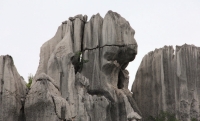Clustered stone forest in Pu Dou Chun (Yunnan, China)
DOI:
https://doi.org/10.3986/ac.v51i1.10688Keywords:
stone forest-Shilin, rock, rock relief, complexometry, Yunnan, ChinaAbstract
One of the unique examples of the development of subsoil karren into a stone forest on the varied geological bedrock of the Lunan surface is revealed to us. Originally of subsoil formation and later denuded, the rounded hills that dissect the karst surface have transformed into a clustered stone forest whose central part usually consists of a larger dissected rock mass with individual stone pillars and teeth at the edge. The geologic profile contains beds of dense, homogeneous and compact fine-grained limestones that alternate with beds of mostly coarse-grained and just as compact dolomitised limestones. These bed properties are also reflected in the exterior of the rock as a diverse relief. The average calcium carbonate content in both types of rocks combined is 97.3%. The rock is thickly bedded to massive; beds are mainly positioned subhorizontally. The contacts between the beds of limestone and dolomitised limestone are sharp and clearly visible, especially in the bottom part of the geologic profile, whereas in the central part, they are often blurred and one type of rock grades continuously into the other. In the areas containing limestone, individual bedding planes are especially visible. As can be inferred, the slightly more porous dolomitised rock, made up of larger particles, disintegrates faster in a more permanently waterlogged acid subsoil environment, where the moisture penetrates it deeper. However, as it takes longer to dissolve, it protrudes from the surface of the dolomitic limestone rock when exposed to moisture from occasional rain. The composition and fracturing of the diverse rock strata decisively influences the shape of the pillars and their rock relief. Larger subsoil rock forms (channels, notches, half-bells) have developed on all rock strata. The diversity of the rock is also reflected by the notches that have formed under the soil along the more rapidly soluble partly dolomite rock strata. Denuded subsoil-shaped pillars are reshaped by rainwater and trickling water. Smaller rock forms carved by rainwater have formed mostly only on evenly composed, fine- grained limestone rock. The tops on such rock are more distinctly conical and blade-like and wider on more slowly soluble rock.
Downloads
References
Chen, X., Gabrovšek, F., Huang, C., Jin, Y., Knez, M., Kogovšek, J., Liu, H., Mihevc, A., Otoničar, B., Petrič, M.. Shi, M., Slabe, T., Šebela, S., Wu, W., Zhang, S. & N. Zupan Hajna (eds.), 1998. South China Karst 1. Založba ZRC, 247 pp, Ljubljana.
Engelhardt, W., Füchtbauer, H., Müller, G., 1964. Sediment-Petrologie, Methoden der Sediment-Untersuchung, Teil 1. E. Schweizerbart´sche Verlagsbuchhandlung (Nägele u. Obermiller), 303 pp, Stuttgart.
Evamy, B.D., Sherman, D.J., 1962. The application of chemical staining techniques to the study of diagenesis of limestones.- Proc. Geol. Soc. London, 1599, 102‒103.
Goddard, E.N., Parker, D.T., Ronald, K.D.F., Olaf, N.R., Joseph, T.S., Overbeck, R.M., 1970. Rock-Color Chart. The Geological Society of America, Boulder.
Knez, M., 1997. Prvi rezultati raziskav kamnine v treh lunanskih kamnitih gozdovih
(Yunnan, Kitajska). Acta Carsologica, 26(2), 431‒439.
Knez, M., Slabe, T., 2001a. Oblika in skalni relief stebrov v Naigu kamnitem gozdu (JZ Kitajska). Acta Carsologica, 30(1), 13‒24.
Knez, M., Slabe, T., 2001b. The Lithology, Shape and Rock Relief of the Pillars in the Pu Chao Chun Stone Forest (Lunan Stone Forests, NW China). Acta Carsologica, 30 (2), 129‒139.
Knez, M., Slabe, T., 2002. Lithological and morphological properties and rock relief of the Lunan stone forests. In: Gabrovšek, F. (ed.) Evolution of Karst: From Prekarst to Cessation. Založba ZRC, pp. 259‒266, Ljubljana.
Knez, M., Slabe, T., 2006. Lithological and Morphological Characteristics and Rock Relief of the Lao Hei Gin Shilin Stone Forest (Lunan, SW China). Acta Carsologica, 35(1), 99‒104.
Knez, M., Slabe, T., 2007. Shilin : the formation of stone forests in various rock types (Lunan, Yunnan, China). Acta geologica sinica, 81(1), pp. 148‒157.
Knez, M., Liu, H., Slabe, T., 2011. South China Karst 2. Založba ZRC, 237 pp, Ljubljana.
Knez, M., Liu, H., Slabe, T., 2012. Major stone forest, litomorphogenesis and development of typical shilin (Yunnan, China) = Osrednji kamniti gozd; kamnina, skalni relief in razvoj značilnega šilina (Junan, Kitajska). Acta Carsologica, 41(2‒3), pp. 205‒218.
Knez, M., Liu, H., Slabe, T., 2017. Shui Jing Po Shilin, rock and relief of stone forests on Cone Hills, Yunnan, China. In: Renard, Ph., Bertrand, C. (eds.). EuroKarst 2016, Neuchâtel: advances in the hydrogeology of karst and carbonate reservoirs. Advances in karst science. Springer, pp 3‒19, Cham.
Slabe, T., Liu, H., 2009. Significant subsoil rock forms. In: Ginés, A., Knez, M., Slabe, T., Dreybrodt, W. (eds.) Karst Rock Features: Karren Sculpturing, Carsologica, 9, pp 123‒137, Ljubljana.
Song, L. et al. (eds.) 1997. Stone Forest, a Treasure of Natural Heritage. China Environmental Science Press, 136 pp, Beijing.

Downloads
Published
How to Cite
Issue
Section
License

This work is licensed under a Creative Commons Attribution-NonCommercial-NoDerivatives 4.0 International License.
Authors guarantee that the work is their own original creation and does not infringe any statutory or common-law copyright or any proprietary right of any third party. In case of claims by third parties, authors commit their self to defend the interests of the publisher, and shall cover any potential costs.
More in: Submission chapter




